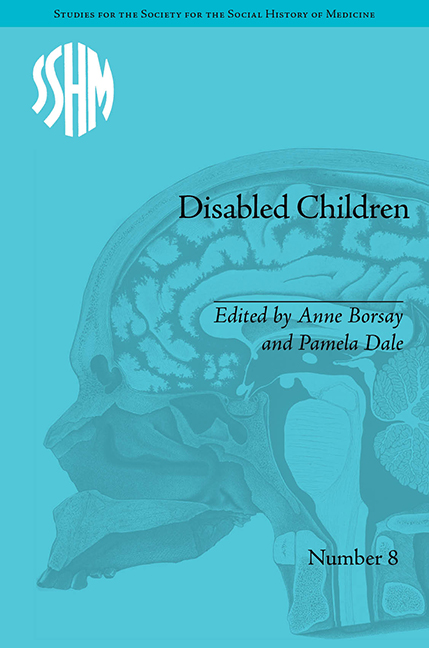Book contents
- Frontmatter
- Contents
- Acknowledgements
- Notes on Contributors
- Introduction: Disabled Children – Contested Caring
- 1 Club Feet and Charity: Children at the House of Charity, Soho, 1848–1914
- 2 Insanity, Family and Community in Late-Victorian Britain
- 3 The Mixed Economy of Welfare and the Care of Sick and Disabled Children in the South Wales Coalfield, c. 1850–1950
- 4 The Question of Oralism and the Experiences of Deaf Children, 1880–1914
- 5 Exploring Patient Experience in an Australian Institution for Children with Learning Disabilities, 1887–1933
- 6 From Representation to Experience: Disability in the British Advice Literature for Parents, 1890–1980
- 7 Treating Children with Non-Pulmonary Tuberculosis in Sweden: Apelviken, c. 1900–30
- 8 Health Visiting and Disability Issues in England before 1948
- 9 Spanish Health Services and Polio Epidemics in the Twentieth Century: The ‘Discovery’ of a New Group of Disabled People, 1920–70
- 10 Cured by Kindness? Child Guidance Services during the Second World War
- 11 Education, Training and Social Competence: Special Education in Glasgow since 1945
- 12 Hyperactivity and American History, 1957–Present: Challenges to and Opportunities for Understanding
- Notes
- Index
1 - Club Feet and Charity: Children at the House of Charity, Soho, 1848–1914
- Frontmatter
- Contents
- Acknowledgements
- Notes on Contributors
- Introduction: Disabled Children – Contested Caring
- 1 Club Feet and Charity: Children at the House of Charity, Soho, 1848–1914
- 2 Insanity, Family and Community in Late-Victorian Britain
- 3 The Mixed Economy of Welfare and the Care of Sick and Disabled Children in the South Wales Coalfield, c. 1850–1950
- 4 The Question of Oralism and the Experiences of Deaf Children, 1880–1914
- 5 Exploring Patient Experience in an Australian Institution for Children with Learning Disabilities, 1887–1933
- 6 From Representation to Experience: Disability in the British Advice Literature for Parents, 1890–1980
- 7 Treating Children with Non-Pulmonary Tuberculosis in Sweden: Apelviken, c. 1900–30
- 8 Health Visiting and Disability Issues in England before 1948
- 9 Spanish Health Services and Polio Epidemics in the Twentieth Century: The ‘Discovery’ of a New Group of Disabled People, 1920–70
- 10 Cured by Kindness? Child Guidance Services during the Second World War
- 11 Education, Training and Social Competence: Special Education in Glasgow since 1945
- 12 Hyperactivity and American History, 1957–Present: Challenges to and Opportunities for Understanding
- Notes
- Index
Summary
Introduction
Charitable activity grew rapidly in Britain from the late eighteenth century and disabled people were caught up in this expansion. Blindness and deafness were popular causes because these sensory impairments denied access to the word of God and hence appealed to Christian sympathies. Support for physical disabilities was slower to arrive, gathering pace after the 1870 Education Act revealed how many ‘crippled’ children did not receive schooling. Therefore, the House of Charity for Distressed Persons, founded in Soho in 1846, was unusual in caring for physically disabled children. This was not part of its original plan. The House was largely the achievement of a group of Anglo-Catholic laymen, known as the Engagement, whose members agreed to perform regular acts of charity. Their aim was twofold; to provide temporary shelter for suitably selected or recommended persons in London, and to give an opportunity for association with charitable activity to those too busy to get directly involved themselves. Its involvement in the provision of temporary accommodation for children with disabilities came about almost by accident. Although contrary to the founders' original intentions, it was probably a necessary response to the urgent need to keep its beds full, both to ensure a regular income from those benefactors who pledged to pay for the care of individual inmates, and to satisfy the spiritual needs of those of its supporters for whom the financial support of the House of Charity was a religious exercise, as well as a response to pressure from its supporters for a place of refuge for children receiving treatment in the capital.
- Type
- Chapter
- Information
- Disabled ChildrenContested Caring, 1850–1979, pp. 15 - 28Publisher: Pickering & ChattoFirst published in: 2014



